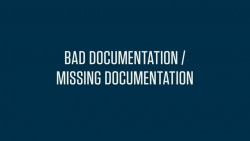Please note that these scenarios, medical reports, and coding examples are all theoretical. Some of them may have been simplified for space. They are presented solely as teaching examples.
Example 1
Let’s start off with a relatively straightforward visit to the doctor’s office. Here’s some context: our patient is in his late 20s and has not seen this doctor before. He’s had a fever, a cough, some slight chest pain, and difficulty breathing.
Here’s the hypothetical medical report.
Patient is a 27-year-old white male. Not an established patient. Height is 74 inches, weight 220 lbs. Patient states he is allergic to penicillin, but has no other outstanding medical history. Does not smoke, exercises moderately.
Patient presents with chills, headache, cough, fever (101 degrees), difficulty breathing. Examination via stethoscope yields heavy rales. Percussion test on thorax suggests buildup in lungs. Streptococcal pneumoniae suspected.
Obtained blood sample for Antistreptolysin O titer. Results yield level of ASO above 200. Diagnosis of streptococcal pneumoniae confirmed.
Prescribed patient two weeks of 500mg azithromycin (Zithromax), and scheduled follow-up for next week.
Let’s start abstracting the information from this medical report. We can start right away with the most straightforward code: the diagnosis. The doctor has diagnosed streptococcal pneumoniae in this patient. (Remember, we always code the definitive diagnosis, meaning we wouldn’t code the cough, fever, or any of the other symptoms unless the doctor could come to a definitive diagnosis).
So, in order to get the proper diagnosis code, we turn to the ICD-10-CM manual. We’d look to the range J00– J99, for Diseases of the Respiratory System. In that section we’d find “J13 – pneumonia due to Streptococcus pneumoniae,” which is the code we’re looking for: pneumonia caused by streptococcal bacteria. In this case, there are no subcategories or subclassifications. J13 is our diagnosis code.
(Bear in mind that you could also just look up Streptococcus Pneumoniae in the alphabetic index of ICD-10-CM. We’re taking the long route for the sake of instruction).
Now we get into the procedure codes. There are a couple here. Firstly, since a new patient is coming into the doctor’s office with an as-yet unspecified condition, we know it’s an Evaluation and Management (E&M) procedure. Secondly, we see that the doctor performed a test on the patient to confirm the diagnosis. That’s a pathology and laboratory test.
Let’s start with the E&M codes. You may think that the prescription of medication by the doctor falls into yet another category of procedure, but prescribing a medication is actually part of the E&M process. So too are the basic examinations the doctor performed (the thoracic percussion and the use of the stethoscope). Those are each part of the History, Exam, and Medical Decision-Making portions of E&M codes, often abbreviated to HEM. The doctor asked the patient about his history, he performed various exams, and he made a medical decision to prescribe antibiotics.
When you’re selecting E&M codes, you look at the intensity of the evaluation and patient management. We can do this by the time spent with the patient, or we can do it by evaluating the amount of work that goes into the HEM.
E&M codes will list the level of intensity (and the time) of the procedure in their description. In our example, since the patient is new, there will be a more involved ‘history’ section of HEM. This would go with a thorough examination. The medical decision-making of prescribing antibiotics by oral administration is relatively low-risk, so this E&M procedure would probably be of low to moderate complexity.
Since the patient is a new patient, we’d look for codes in that subsection of E&M. We’d find code 99203, which includes a “detailed history; a detailed examination; medical decision making of low complexity.” That’s our E&M code.
But the doctor also performed a test that confirmed his diagnosis. How do we code that? Since the doctor took a sample from the patient to test, we know it’s in the Pathology Section of the CPT Manual.
A little medical background here: the test in the medical report was an Antistreptolysin O, or ASO, titer. A titer is a type of test. ASOs are antibodies the immune system creates to combat streptococcal bacteria. The human body typically has around 200 units of ASO as a baseline. If a test confirms a heightened level of ASO, that’s usually a definitive sign of the presence of strep bacteria.
We can find the test for ASO in the immunology subsection of Pathology. We could also look up antistreptolysin in the index at the back of the CPT manual. Both methods would lead us to the CPT code 86060, “antistreptolysin; titer.” That’s our Pathology code.
Now what about the medication the doctor’s prescribed to our patient? We’d include that as part of our medical decision making process—the prescription of antibiotics is the decision the doctor made for the patient. However, if we wanted to add it to the E&M code to give the payer more information, we can do that pretty easily.
Previously, we talked about Category II CPT codes as useful for administrative and performance management purposes, but they can also be used in informational settings. These Category II codes are optional, and are added to Category I codes with a hyphen. We’d look up the proper Category II code in the index under “antibiotic administration.” That would point us to 4120F, “antibiotics prescribed or dispensed.” We’d flip there in Category II to confirm.
So we’d add the Category II CPT code 4120F to our extant E&M code 99203 to get 99203-4120F, which is a new patient visit of low complexity, with the prescription or dispensation of antibiotics.
So our codes would be…
Procedure
99203-4120F (E&M)
86060 (Pathology)
Diagnosis
J13
We’d enter these into a superbill that would include…
- The patient’s information
- The provider information
- Procedure information
- Diagnostic information
We’d then send that superbill on to the medical biller so that they could create the medical claim.
Let’s look at another hypothetical situation, this time involving surgery.
Example 2
We’ll jump right in with our medical report. This one, you’ll note, is different in format from the previous one. There’s no uniform style of medical report, so coders should be prepared to abstract information from a whole variety of reports.
CHIEF COMPLAINT: Pain and swelling in abdomen
HISTORY OF PRESENT ILLNESS: Patient is a 67-year-old female presents to the emergency room with sharp, shooting pain in her lower abdomen and pronounced swelling. Patient is nauseous, has vomited, and has a fever. Abdomen is firm and slightly distended. Patient states she has no history of abdominal problems, disease, or hernia.
PAST MEDICAL HISTORY: Patient is on a program of anti-depressants, but is otherwise physically sound. States she has never been admitted for any abdominal problems.
CURRENT MEDICATIONS: Wellbutrin, 5 mg daily
ALLERGIES: None
SOCIAL HISTORY: Used to smoke (using Wellbutrin to quit) and does not drink
REVIEW OF SYMPTOMS: As above
PHYSICAL EXAMINATION:
Vital Signs: Blood pressure is 150/88, with a fever of 102 degrees.
Skin: Warm and dry and normal, except in lower abdomen, where it is swollen and tight
Chest: no respiratory problems detected
Cardiac: regular rhythm
Back: No abnormalities detected
Abdomen: is firm above the pelvic bones. Patient experiences pain upon palpation. Blumberg sign elicits painful response, as does a forced cough. Abdomen is tight and swollen.INTERVENTION: Physical examination suggests appendicitis. Ultrasound test ordered, and diagnosis of appendicitis is confirmed. Patient is rushed to surgery and is prepped for general anesthesia. Once anesthetized, patient receives appendectomy via laparoscopy. Exploration during surgery reveals no signs of peritonitis, local or general. Following surgery, patient is taken to observation room, and then to hospital room. Patient responds well to surgery, and is discharged later that night with a prescription for pain medication.
Diagnosis: Acute appendicitis
As you can tell, this medical report is significantly more involved than our first one. Thankfully, it’s a pretty direct procedure, so we can dive right in. Let’s start with the diagnosis.
As listed above, the diagnosis is acute appendicitis. To find this in ICD-10-CM, we’d look for Diseases of the Digestive System. In that section we’d find the code for acute appendicitis: K35. Under that code we’d find multiple subcategories. As we saw in the medical report, there was no sign of any peritoneal complications, so we’d choose K35.80, unspecified acute appendicitis. That’s our diagnosis code.
Let’s move on to procedure codes. We’ll start again with E&M. This is an emergency department services code. Emergency codes, like outpatient or office codes, are coded depending on the intensity/risk of the procedure. When our patient checks in, she’s not in directly life-threatening danger, but if the appendicitis goes septic, it could endanger her life. With that in mind we’d pick the E&M code 99284, a visit for a condition that “requires urgent evaluation by the physician…. but [does] not pose an immediate significant threat to life or physiological function.” So, 99284 is our E&M code.
Of course, our procedure coding doesn’t stop there. As we saw from the medical report, the emergency department performed an ultrasound to confirm their diagnosis, and performed a surgical procedure with general anesthesia. This means we need three more codes: a Radiology code (for the ultrasound), a Surgery code (for the appendectomy), and an Anesthesia code (for the general anesthesia).
Let’s start with the ultrasound. Diagnostic ultrasounds are found after diagnostic radiology (e.g. x-rays) in the Radiology Section. We’d look for a diagnostic ultrasound for the abdomen and find 76700, for “ This means it’s an ultrasound for the entire abdomen. That’s close, but not exactly what we want. Below 76700 you’ll see code 76705, for a limited abdominal ultrasound of a single organ or quadrant. That’s what we want. So 76705 is our Radiology code.
Let’s move to Surgery. The Surgery Section is relatively straightforward. We find the procedure we want by the area of the body it’s performed on. In our case, we’d turn to the digestive system (recall that the appendix is attached to the large intestine). There we’d find codes for the appendix, including incision, excision, and laparoscopy. We’re looking for an appendectomy done via laparoscopy, so we’d look at laparoscopy codes, and we’d select 44970, laparoscopy, surgical, appendectomy. That’s our Surgery code.
With every surgery we’ll need some sort of Anesthesia code. Per the medical report, the patient received general anesthesia, but we select Anesthesia codes based on the location of the procedure performed under the anesthetic. So the Anesthesia code would be located under “Lower Abdomen” in the Anesthesia Section. Specifically, we’d choose 00840, Anesthesia for intraperitoneal procedures in lower abdomen including laparoscopy; not otherwise specified.” Remember also that with every Anesthesia code, you need to add a physical status modifier. These are found in the Anesthesia section, and are added to the Anesthesia code to describe the condition of the patient. In our example, the patient is a P3—the patient has a severe systemic disease (since appendicitis can go septic, and thus potentially life-threatening, it’s regarded as severe). So our Anesthesia code is 00840-P3.
Here’s what we’d end up with:
Procedure:
99284 (E&M)
76705 (Radiology)
44970 (Surgery)
with 00840-P3 (Anesthesia)
Diagnosis:
K35.80 – Unspecified acute appendicitis
We’d include that information in a superbill, along with the provider information (in this case it’d be a hospital), patient information, and prices. We’d send those on to the medical biller, whose work we’ll explore in the next Course.



